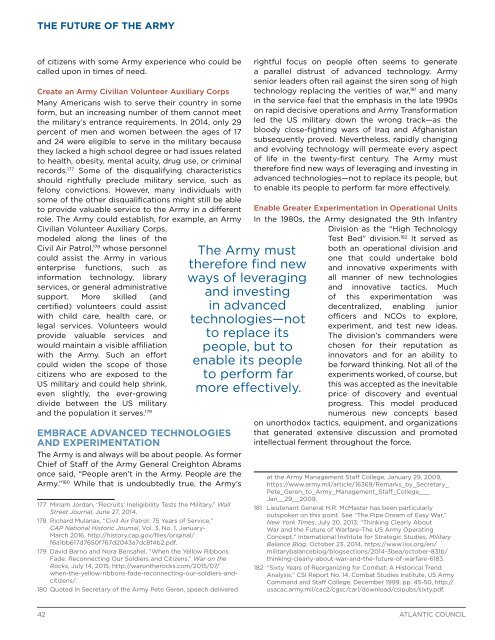FUTURE ARMY
Future_of_the_Army_web_0921
Future_of_the_Army_web_0921
Create successful ePaper yourself
Turn your PDF publications into a flip-book with our unique Google optimized e-Paper software.
THE <strong>FUTURE</strong> OF THE <strong>ARMY</strong><br />
of citizens with some Army experience who could be<br />
called upon in times of need.<br />
Create an Army Civilian Volunteer Auxiliary Corps<br />
Many Americans wish to serve their country in some<br />
form, but an increasing number of them cannot meet<br />
the military’s entrance requirements. In 2014, only 29<br />
percent of men and women between the ages of 17<br />
and 24 were eligible to serve in the military because<br />
they lacked a high school degree or had issues related<br />
to health, obesity, mental acuity, drug use, or criminal<br />
records. 177 Some of the disqualifying characteristics<br />
should rightfully preclude military service, such as<br />
felony convictions. However, many individuals with<br />
some of the other disqualifications might still be able<br />
to provide valuable service to the Army in a different<br />
role. The Army could establish, for example, an Army<br />
Civilian Volunteer Auxiliary Corps,<br />
modeled along the lines of the<br />
Civil Air Patrol, 178 whose personnel<br />
could assist the Army in various<br />
enterprise functions, such as<br />
information technology, library<br />
services, or general administrative<br />
support. More skilled (and<br />
certified) volunteers could assist<br />
with child care, health care, or<br />
legal services. Volunteers would<br />
provide valuable services and<br />
would maintain a visible affiliation<br />
with the Army. Such an effort<br />
could widen the scope of those<br />
citizens who are exposed to the<br />
US military and could help shrink,<br />
even slightly, the ever-growing<br />
divide between the US military<br />
and the population it serves. 179<br />
EMBRACE ADVANCED TECHNOLOGIES<br />
AND EXPERIMENTATION<br />
The Army is and always will be about people. As former<br />
Chief of Staff of the Army General Creighton Abrams<br />
once said, “People aren’t in the Army. People are the<br />
Army.” 180 While that is undoubtedly true, the Army’s<br />
177 Miriam Jordan, “Recruits’ Ineligibility Tests the Military,” Wall<br />
Street Journal, June 27, 2014.<br />
178 Richard Mulanax, “Civil Air Patrol: 75 Years of Service,”<br />
CAP National Historic Journal, Vol. 3, No. 1, January-<br />
March 2016, http://history.cap.gov/files/original/<br />
f6a1bb617d7650f767d2043a7dc8f4b2.pdf.<br />
179 David Barno and Nora Bensahel, “When the Yellow Ribbons<br />
Fade: Reconnecting Our Soldiers and Citizens,” War on the<br />
Rocks, July 14, 2015, http://warontherocks.com/2015/07/<br />
when-the-yellow-ribbons-fade-reconnecting-our-soldiers-andcitizens/.<br />
180 Quoted in Secretary of the Army Pete Geren, speech delivered<br />
The Army must<br />
therefore find new<br />
ways of leveraging<br />
and investing<br />
in advanced<br />
technologies—not<br />
to replace its<br />
people, but to<br />
enable its people<br />
to perform far<br />
more effectively.<br />
rightful focus on people often seems to generate<br />
a parallel distrust of advanced technology. Army<br />
senior leaders often rail against the siren song of high<br />
technology replacing the verities of war, 181 and many<br />
in the service feel that the emphasis in the late 1990s<br />
on rapid decisive operations and Army Transformation<br />
led the US military down the wrong track—as the<br />
bloody close-fighting wars of Iraq and Afghanistan<br />
subsequently proved. Nevertheless, rapidly changing<br />
and evolving technology will permeate every aspect<br />
of life in the twenty-first century. The Army must<br />
therefore find new ways of leveraging and investing in<br />
advanced technologies—not to replace its people, but<br />
to enable its people to perform far more effectively.<br />
Enable Greater Experimentation in Operational Units<br />
In the 1980s, the Army designated the 9th Infantry<br />
Division as the “High Technology<br />
Test Bed” division. 182 It served as<br />
both an operational division and<br />
one that could undertake bold<br />
and innovative experiments with<br />
all manner of new technologies<br />
and innovative tactics. Much<br />
of this experimentation was<br />
decentralized, enabling junior<br />
officers and NCOs to explore,<br />
experiment, and test new ideas.<br />
The division’s commanders were<br />
chosen for their reputation as<br />
innovators and for an ability to<br />
be forward thinking. Not all of the<br />
experiments worked, of course, but<br />
this was accepted as the inevitable<br />
price of discovery and eventual<br />
progress. This model produced<br />
numerous new concepts based<br />
on unorthodox tactics, equipment, and organizations<br />
that generated extensive discussion and promoted<br />
intellectual ferment throughout the force.<br />
at the Army Management Staff College, January 29, 2009,<br />
https://www.army.mil/article/16369/Remarks_by_Secretary_<br />
Pete_Geren_to_Army_Management_Staff_College___<br />
Jan__29__2009.<br />
181 Lieutenant General H.R. McMaster has been particularly<br />
outspoken on this point. See “The Pipe Dream of Easy War,”<br />
New York Times, July 20, 2013; “Thinking Clearly About<br />
War and the Future of Warfare–The US Army Operating<br />
Concept,” International Institute for Strategic Studies, Military<br />
Balance Blog, October 23, 2014, https://www.iiss.org/en/<br />
militarybalanceblog/blogsections/2014-3bea/october-831b/<br />
thinking-clearly-about-war-and-the-future-of-warfare-6183.<br />
182 “Sixty Years of Reorganizing for Combat: A Historical Trend<br />
Analysis,” CSI Report No. 14, Combat Studies Institute, US Army<br />
Command and Staff College, December 1999, pp. 45-50, http://<br />
usacac.army.mil/cac2/cgsc/carl/download/csipubs/sixty.pdf.<br />
42 ATLANTIC COUNCIL


